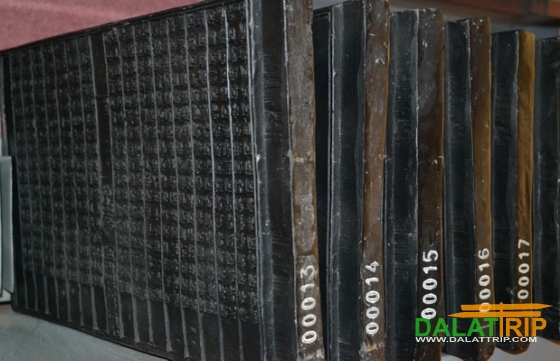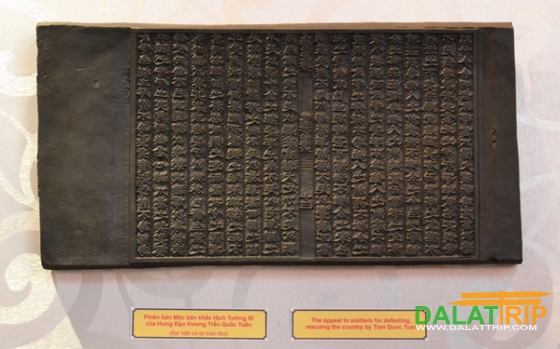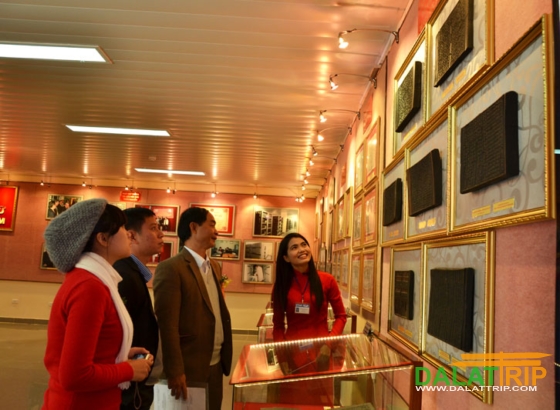Nguyen Dynasty Woodblocks – world document heritage in Dalat
For tourists, when they come to Da Lat nowadays, they are not only immersed in the fresh, beautiful scenery with a multitude of flowers blooming everywhere, but also enjoy and watch a unique form of Vietnamese documentation, of international characteristic: Nguyen Dynasty Woodblocks – a world documentation heritage.
What are Woodblocks
Woodblocks documentation consists of pieces of woodblocks carved in reverse Chinese characters or ancient Vietnamese scripts to be printed, widely used in Viet Nam during feudal periods. Under Nguyen Dynasty, due to demand for spreading social norms or laws imposed on the people, or to preserve the King’s fame and glory, or historical events … the royal court had compiled and engraved many of documents and history volumes to be distributed to many places. Hence the production a special type of documentation, or woodblocks. Wood used to engrave characters on used to be the wood taken from pear trees, or apple trees. According to the “Dai Nam nhat thong chi” book, “ wood used to carve characters was taken from the Nha Dong tree, with white wood textures, and as bright as elephant’s ivory”.
Records of Woodblocks
The place of birth of the woodblocks is the National Historic Woodblocks office founded in 1820 during the 1st year of Minh Mang reign; this is the public authority body responsible for the compilation of national history, royal annals and special educational and geographical publications… additionally, this body was responsible for the research, engraving and printing of woodblocks. This is a quite elaborate, careful compilation spreading over long periods, some volumes have been compiled during 88 years upon completion, for instance, the “Đại Nam Thực lục”. During the engraving process, responsible officials at the Academy stringently looked after the work of highest exclusive carving boards.

Nguyen Dynasty Woodblock
The National History Office has compiled many valuable history books, such as “Dai Nam thuc luc”,“ Dai Viet su ky toan thu”,“Kham Dinh Viet su Thong Giam cuong muc”,“Dai Nam nhat thong chi”,“Minh Mang chinh yeu”,“Hoang Viet law”… In addition, many carving boards are related to international culture and history of several countries such as USA, France, Spain, Portugal, China, Thailand, Laos, Cambodia, to name a few. Particularly, many woodblocks confirmed Viet Nam’s sovereignty of Hoàng Sa and Trường Sa islands.
In the 2nd year of Minh Mang reign (1821), the Nguyen founded the Temple of Literature (Quoc Tu Giam), built at the west of the imperial city, consisting of Di Luan Duong and rows of rooms. In addition to functional training, the Temple of Literature received, preserved, restored wooden boards for printing, which were collected from Ha Noi Temple of Literature for storage at the Temple of Literature in Hue in the reigns of King Minh Mạng and Thiệu Trị.

Nguyen Dynasty Woodblocks
The woodblocks were brought to the rooms of the Temple of Literature, looked after and regularly checked by officials; at the same time, “ had students check old public documents, to find faulted characters for re-carving”. This has shown that the storage of woodblocks is implemented very carefully, from collection, storage to preservation, restoring and printing, to serve the need of teaching and learning of the school and the society.
After 1954, the country was divided into two parts: the south and the north; southern Vietnam was ruled by Republican President Ngo Dinh Diem. Shortly after coming to power, Diem began transferring all the Nguyen Dynasty woodblocks from Hue to Da Lat to preserve. These woodblocks were stored in three different places, namely 24 Yersin (At the ground floor and the basement); 14 Yersin (at the basement of the former national bank) and at No. 3 Trần Hưng Đạo. From 1961 through 1975, the woodblocks were preserved at the Archive Branch and Da Lat National Library.

exhibition of Nguyen Dynasty Woodblock
After liberation, woodblocks documentation was managed by the Archive Department belonging to the Presidency Palace of the provisional revolutionary government of the Republic of South Viet Nam. Since 1976, Nguyen Dynasty woodblocks were delivered to the Central Storage Bureau No. II (now the National Storage Center) by the Central Archive – storage Bureau (now the State Archive and Documentation Bureau) to manage and preserve at the Congregatio Sanctissimi Redemptoris. In 1988, the woodblocks were delivered to Tran Le Xuan Palace (former Palace). From August 2006 until now, Nguyen Dynasty woodblocks were transferred to the National Archive Center No. IV (2 Yet Kieu, Da Lat) to manage, preserve and promote the value of these woodblocks. Currently, the Center is preserving a great quantity of woodblock documentations including 34,619 original boards with 55,320 engravings . The complete woodblocks are revised on 9 themes such as history, geography, military, legislation, literature … consisting of 152 titles with 1,953 volumes.

exhibition of Nguyen Dynasty Woodblocks
The National Archive Center No. IV is assigned to take over the entire campus of Tran Le Xuan Palace, ever known as “Number One monument of the South– a weekend retreat of the counselor of the Sai Gon government – Ngo Dinh Nhu, brother of President Ngo Dinh Diem; and the old villas are used to be the showroom of national archive documentations. The showroom area of national archives and documentations is open to the public and international tourists to watch and study the woodblocks heritage on weekdays, and weekends – Saturdays and Sundays and during Tet holidays; this is a fairly complete and useful historical source serving the research of the history, culture and society of Viet Nam under the Nguyen Dynasty.
By Tran Minh




